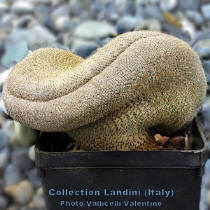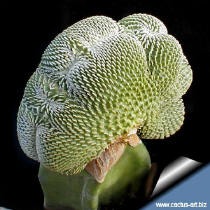| |
|
|
|
| |
|
Fasciation or
cristation is an abnormal
development of an
apical meristem characterized by
indeterminate
proliferative growth.
A plant becomes crested when its apex
develops laterally from a
linear meristem rather than a single
point |
|
| |
|
|
|
From the Latin word “fascia”, meaning “a
band”.
|
|

(Photo 1)
Rebutia heliosa
forma cristata
This crest clearly shows the
elongated line of growth (due to a linear meristem) at the tip. |
Fasciation or cristation is a widespread
phenomena that may
randomly affect
vascular plants both
in nature and in
culture. Out of 290
families the fasciations
were found at least in 107 of them. There are no direct
confirmation of absence of fasciations in any of
taxonomic groups of
vascular plants.
A fasciation (abrupt changes of
organ forming activity of
meristems resulting from
somatic mutations)
is an abnormal enlargement or
coalescence of a shoot
tips ( not a
disease) in which a single
apical meristem has
become unusually broadened and flattened , suggesting many
stems have fused together
(Photo 1),
this establish the following
unlimited growth,
As a result the shoots have
axial symmetry
instead of central
symmetry. The
plants reached take initially the form of a fan, then undulate,
and end up resembling brains (Photo 2).
Side shoots
are usually absent or remain small and undeveloped. It is
especially prevalent in species with
indeterminate
growth patterns. Although there is another much rarer type, characterised by a
ring-shaped growing point, which produces a hollow shoot (ring
fasciation). |
Some cristation are real living
sculptures, sought after by collectors, coveted by plant
amateurs, and widely cultivated by commercial grower, they look
very outstanding when potted and certainly attract a lot of
attention.
The plant showing this abnormal growth are indicated as "forma
cristata" or "f.
cristata" following the name of the species |
| |
|
|
|
|
| |
1) |
Genetic
Fasciation
It is not truly known if the fasciations are
inherited. However, the
tendency toward fasciation is
transmissible by budding
and grafting once the plant
develops a fasciation. Growers who
prune off fasciated branches
often find this condition returns with the
development of new
branches. At least in some occurrences fasciation is controlled in
plants by genes. Many species
exhibit true-breeding fasciated
lines, although the
expression of the
character is
very dependent on environmental
conditions - especially
temperature and nutrition.
Because the gene conditioning
fasciation exhibits incomplete
penetrance, the character may assume any of many degrees of
expression. The cockscomb
celosia (Celosia argentea var. cristata) is an
excellent example of a plant with inherited fasciation. |
|
| |
2) |
Physiological Fasciation |
|
| |
|
A) |
Natural
Environmental
Factors |
|
| |
|
|
I |
Attack by Insects. Several insect species have been found to
produce fasciation. |
|
| |
|
|
II |
Pressure. Underground
shoots that pierce the
ground, such as
asparagus, tend to become fasciated. |
|
| |
|
|
III |
Seasonal Influences. Time of
sowing may
influence the degree
of fasciation, with earlier sowing appearing to produce larger
numbers of fasciated plants. |
|
| |
|
|
IV |
Crowding: has often been reported to produce a decrease
in the percentage of fasciated plants. |
|
| |
|
|
V |
Temperature. Low temperature followed by high temperature
causes fasciation in Hyacinthus and may be a cause of fasciation in
other plants. |
|
| |
|
|
VI |
Mineral Deficiency.
Zinc deficiency is known to cause
fasciation. |
|
| |
|
B) |
Artificially Applied
Factors
|
|
| |
|
I |
Decapitation of
Seedlings and
Defoliation: Amputation of the
main stem of seedlings induces fasciation in several
species. |
|
| |
|
II |
Wounding of the
Growing Point: Wounding causes fasciation as
well as all kinds of abnormalities. |
|
| |
|
III |
Ionizing Radiation: (X-rays and gamma-rays).
|
|
| |
|
IV |
Infection with
Fungi,
Bacteria, and
Viruses
|
|
| |
|
V |
Polyploidizing Agents (colchicine, morphine, phenyl-urethane,
etc). |
|
| |
|
VI |
Nutrition Good nutrition, including high rates of
nitrogen,
increases the occurrence of fasciation. |
|
| |
|
VII |
Water Shortage Plants with
indeterminate inflorescences when
kept under drought conditions prior to
flowering and then subjected
to heavy watering and high
nutrient levels will produce fasciations
|
|
| |
|
VIII |
Application of Growth Regulators and
Herbicides: TIBA
(2,3,5-triodobenzoic acid), for example, induces fasciation,
particularly ring fasciation, and many other abnormalities,
including distortions and fusion of organs. |
|
| |
|
IX |
Photoperiod: Fasciation may be induced by increasing or
decreasing the photoperiod - the lenght of day experienced by the
plants.
|
|
|
Cristation in cactus and
succulents: |
|

(Photo
3)
Turbinicarpus pseudopectinatus forma inermis cristata |
Cristation is a quite
frequent phenomenon in
Cactaceae ( reported in more than 50
genera) and also in many
other succulents family like
in Euphorbiaceae,
Crassulaceae,
Asclepiadaceae, etc.. A
pure cristation is also completely different then
monstruosity, where
axils (areoles)
are multiple-activated
and the apical meristem
stopped growing.
All column-like and
globular cacti, as well as
Opuntias, can be touched by
this anomaly growth form which remains however rare because it
cannot be caused. One did not find yet a cristation for all the
existing species.
Cactus horticulturists and
collectors believe that cristation results from
somatic mutation(s)
at the apical meristem
region of the main stem or
branches and that a
predilection for occurrence of this mutation is
heritable.
|
|
As a
result of
unlimited growth of linear meristem (see: photo 1) the stem gets flattened,
areolae with
spines are situated on all the
surface of the
crests. The number of ribs
and/or of parastichs
(spiral lines formed by areoles) increases but the structure of
areolae themselves does not practically change. Depending on the
age there are fan-shaped
(Photo 6),
wavy and
brain-shaped crests. More
thick crests seldom grow into brain-shaped (e.g. crests of Carnegia gigantea).
All fasciated species grow faster than normal ones which
corresponds to the opinion of most authors, the increase of
photosynthesizing surface
leads to better carbon
nutrition and faster
growth of fasciated
plants. Crests may remain at any
stage for a long time. But at
the stage of brain-shaped crest when the curves begin to crowd
defasciation (Photo 4) occurs rather often. That is the linear meristem
turns into a number of small
apical meristems that form normal
shoots. Seldom defasciation occurs without
any reason at an earlier stage of the development of the crest.
In general with age meristem gets less
active or not active at
all. The growth continues only at some parts of linear meristem.
Thanks to this process the upper surface becomes uneven. The
more active parts are usually situated at its ends. This type of
developing crest prevails among cacti, and for a long time it
was considered to be the only possible. |

(Photo
4)
Mammillaria luethyi
forma cristata
an example of crest
defasciation |
|

(Photo
5)
Strombocactus disciformis
forma cristata
Juvenile and mature structure in response to the use of
different grafting stocks. |
Many
authors affirm that the crest of
cacti has another specific feature. In spite of their rather
large size the areolae
frequently kept their juvenile
structure and are
situated like at the seedlings
of the species.
Consequently the physiological age of crest may not depend on
its real age and be determined by the
stage of the development
at which it appeared. It is quite possible that the crest that
appeared at a juvenile plant will not be able to
bloom during its
life-time.
But this thesis is not based on a correct observations, the
apparent age of the crest depends mainly by the
hormonal balance furnished
by the grafting stock. It is
a well known phenomenon
that crest grafted on different stocks may be very different one
from each other.
The fact that crest forms flowers rarely is in part due to
the consuetude to graft the crest on strong stock that enhance
only a fast growth and delete the natural
maturation and
flowering. (photo 5) |
In the
ontogenesis a crest can appear any time, but development
of crests at large columnar cactus species ( such as in saguaro
Carnegia gigantea) in the early
stages of ontogenesis is
unlikely. On the other hand small species may crest early
already at the cotyledons
stage.
That means fasciations can take place even in the first days of
a seedling or at the stage of the forming of the
embryo in the
seed. As practice shows when cactus fanciers grow cacti out of
seeds fasciations often take place at germs and
juvenile plants
especially when the regime changes (temperature,
humidity,
grafting onto a strong
stock). It also takes place
in any growing phases without any apparent reasons. |
|
Fasciation in a taxon is
clearly correlates with the degree of
succulent characteristics
of stems. Among widely spread
fasciated plants there are many members the most advanced
subfamily
Cactoideae, which grows in
arid
conditions and are remarkable for the high degree of
succulence. While
primitive
subfamily Pereskioideae which grow in the conditions of sufficient or excessive
humidity, have a high percentage of
photosynthesizing surface to
the volume of the plant and have almost no fasciations.
A larger number of fasciations is found among
xerophytes as compared
with hydrophytes were mentioned earlier for other
families as
well. Among succulents the frequency of fasciations is most
likely to be at evolutionally
advanced
taxa with highly
specialized
vegetative organs. It is
obvious that environmental conditions are more important for the
appearance of fasciations than the origin of the species with
high frequency of fasciations. |

(Photo 6)
Geohintonia mexicana
forma cristata |
| |
|

(Photo 7)
Echeveria coccinea
San Bartolo Co. Hidalgo,
Mexico forma cristata |
Cultivation of crested cacti and succulents.
Cultivation of the cristate forms of cacti is worthy of a special mention
because an accidental appearance of a crest happens quite often
and these plants attract attention of collectors thanks to their
prominent ornamental features. Furthermore the crested forms can
be usually reproduced vegetatively without difficulties Many
crests should be kept on the dry side, in other words, grown
hard. Too much water and/or
fertilizer can cause cracks and
spreading. Trimming any normal shoots off helps the crested form
grow better and truer to form, but sometimes these normal shoots can crest again after some
normal growth. Cuttings from crested cactus should be
grafted
for best results. Cuttings from
other crested succulents can be
replanted after the normal waiting period. Keep these very dry
for at least a week or preferably two weeks and on the dry side
during their normal growing cycle. For
euphorbias, this would be
in the Autumn.
|
|
For some
leaf succulents it is sufficient to have any part of
the mother plant - a
leaf or even an ordinary, non-crested shoot
(Photo 7) in order to reproduce crested form. In other cases
only a fragment of the crested shoot is suitable for
reproduction whereas leaves and normal, not crested shoots don't
inherit desirable qualities. |
|